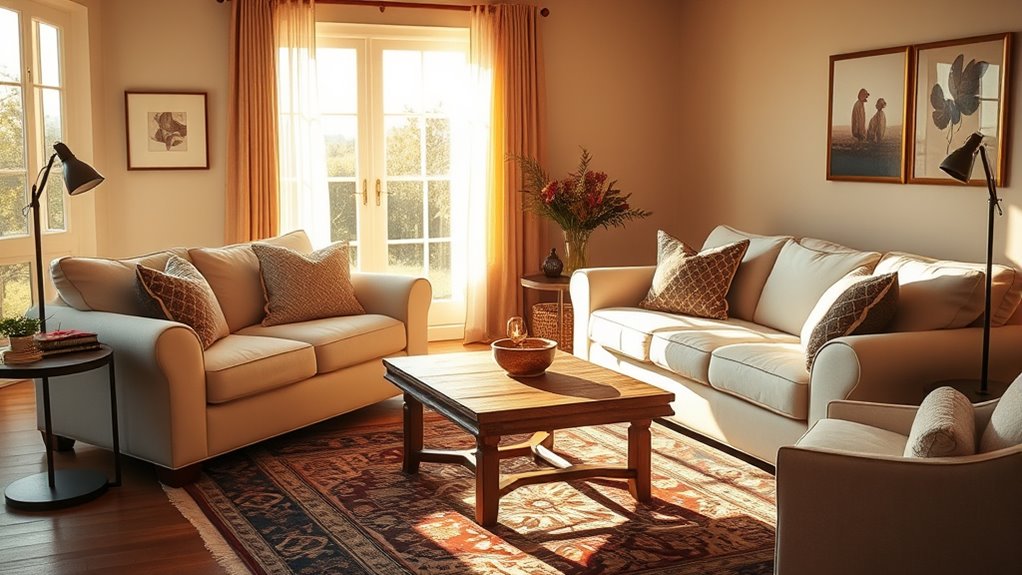To master the art of lighting in your home, start by maximizing natural light with strategic furniture placement and light-colored walls. Add layered lighting with ceiling fixtures, task lamps, and ambient options, and use dimmers to adjust brightness for different moods. Place lamps where they won’t be blocked, and consider light quality to enhance your space’s feel. Keep exploring these tips to create a bright, inviting atmosphere in each room of your home.
Key Takeaways
- Maximize natural light by positioning furniture near windows and using light-colored walls and reflective surfaces.
- Use layered lighting with overhead fixtures, task lamps, and accent lighting tailored to each room’s function.
- Place lamps thoughtfully to avoid shadows, ensuring even illumination and easy access for activities.
- Incorporate dimmers and adjustable lighting to create versatile moods and adapt brightness as needed.
- Choose energy-efficient bulbs and optimize light placement to enhance ambiance while reducing energy consumption.

Good lighting is essential for creating a comfortable and functional home environment. When you think about designing your space, paying attention to how you position lamps and harness natural light can make all the difference. Proper lamp placement isn’t just about adding extra light; it’s about shaping the mood and improving the usability of each room. To start, consider the natural light that flows into your home. You want to maximize this daylight by arranging furniture and fixtures in a way that enhances its reach. For example, place your reading chair near a window so you can enjoy the daylight during the day without relying solely on artificial lighting. Use sheer curtains or blinds that can be opened easily to let in more sunlight. During the day, natural light utilization is key—avoid heavy drapes that block sunlight when you don’t need privacy or blackout conditions. Instead, opt for light-colored walls and reflective surfaces that bounce sunlight around the room, making it feel brighter and more inviting.
When it comes to lamp placement, think about the activities you do in each space. In living rooms, place table lamps on side tables next to sofas or chairs to create cozy corners for reading or relaxing. Floor lamps can illuminate larger areas or be used to add height and visual interest to a space. Position them where they won’t be obstructed, ensuring light spreads evenly without creating harsh shadows. In bedrooms, bedside lamps should be within easy reach for reading or ambient lighting, avoiding placing them behind headboards or in corners where the light doesn’t spread well. Kitchen lighting benefits from layered lighting—overhead fixtures combined with task lamps under cabinets help you see clearly when cooking or preparing food. Incorporating lighting control systems like dimmers allows you to easily adjust the brightness according to your needs and mood. Additionally, understanding the impact of light interaction with your space can help you optimize your lighting setup for both functionality and ambiance. Using light quality considerations such as color temperature can also enhance the overall atmosphere of each room. Recognizing the importance of environmental considerations such as energy efficiency can also guide your choices for sustainable lighting options.
Always think about how light interacts with your space throughout the day. During the morning, a well-lit room with plenty of natural light can invigorate you, while in the evening, strategic lamp placement helps you wind down in a comfortable setting. Use dimmers wherever possible; they give you control over brightness and mood, allowing your lighting to adapt to different times and activities. Remember, the goal is to create a balanced, inviting atmosphere where natural light and carefully placed lamps work together harmoniously. When you pay attention to lamp placement and natural light utilization, your home becomes not just more functional, but also more welcoming and comfortable.
Frequently Asked Questions
How Can I Make Small Rooms Appear Larger With Lighting?
To make small rooms appear larger, you should focus on strategic mirror placement and choosing the right color temperature. Place mirrors opposite windows or light sources to reflect light and create an illusion of space. Use cool white lighting with a higher color temperature to brighten the room and make it feel more open. Avoid heavy, warm tones that can make the space feel cramped. Proper lighting tricks can markedly expand your room’s feel.
What Are the Best Lighting Options for Energy Efficiency?
You can maximize energy efficiency by choosing LED bulbs and energy-saving fixtures. LEDs use less power and last longer, saving you money over time. Opt for fixtures with dimmers or motion sensors to further reduce energy use. Avoid incandescent bulbs, as they waste more energy. By making these smart choices, you’ll enjoy bright, effective lighting while minimizing your environmental impact and lowering your electricity bills.
How Do I Choose Lighting for Different Ceiling Heights?
When choosing lighting for different ceiling heights, consider ceiling height considerations to guarantee proper illumination. For low ceilings, opt for flush or semi-flush fixtures to prevent headroom issues. For high ceilings, select chandeliers, pendant lights, or track lighting that fill the space and add visual interest. Proper fixture selection balances functionality and style, making your room feel inviting and well-lit, regardless of ceiling height.
What Lighting Techniques Create a Cozy Atmosphere?
To create a cozy atmosphere, you should focus on layering lighting with warm ambient lighting like soft overhead fixtures or lamps. Add accent lighting, such as sconces or table lamps, to highlight textures or features and add depth. Use dimmers to adjust brightness easily, making the space feel intimate. Combining these techniques helps you craft a warm, inviting environment perfect for relaxation and comfort.
How Do I Prevent Glare From My Lighting Fixtures?
To prevent glare from your lighting fixtures, focus on glare reduction by choosing fixtures with diffusers or frosted covers. Proper fixture placement also matters—avoid positioning lights directly in your line of sight. Instead, angle fixtures toward walls or ceilings, creating indirect lighting that minimizes glare. You can also use dimmers to control brightness levels, ensuring a comfortable, glare-free environment while maintaining good illumination.
Conclusion
Remember, good lighting isn’t just about brightness—it’s about creating the right mood and functionality for each space. Some believe that natural light always beats artificial, but studies show that well-designed artificial lighting can mimic daylight and boost your mood just as effectively. So, experiment with different setups, trust your instincts, and don’t be afraid to test what feels right. With a little effort, you can turn any room into a welcoming, beautifully lit sanctuary.









